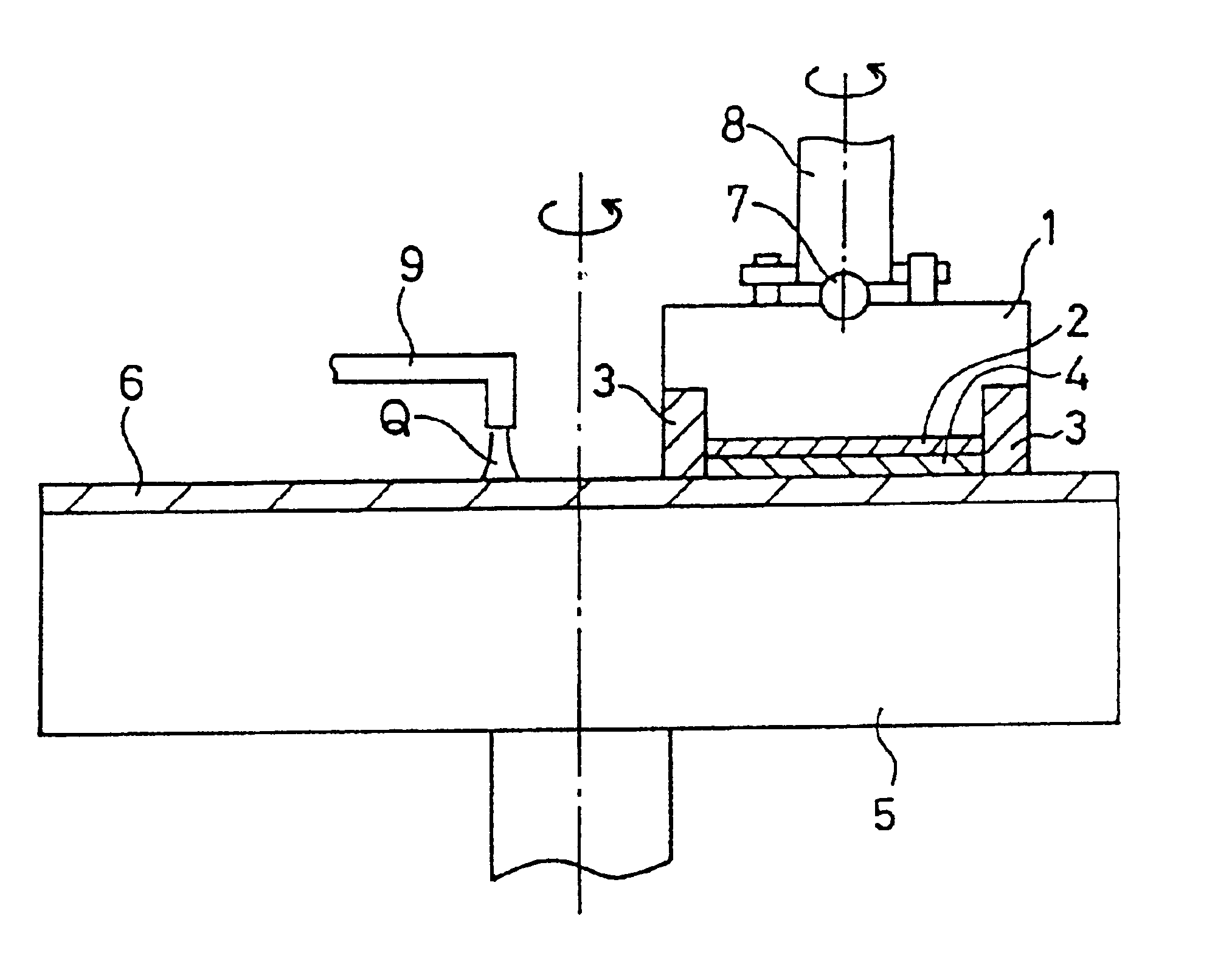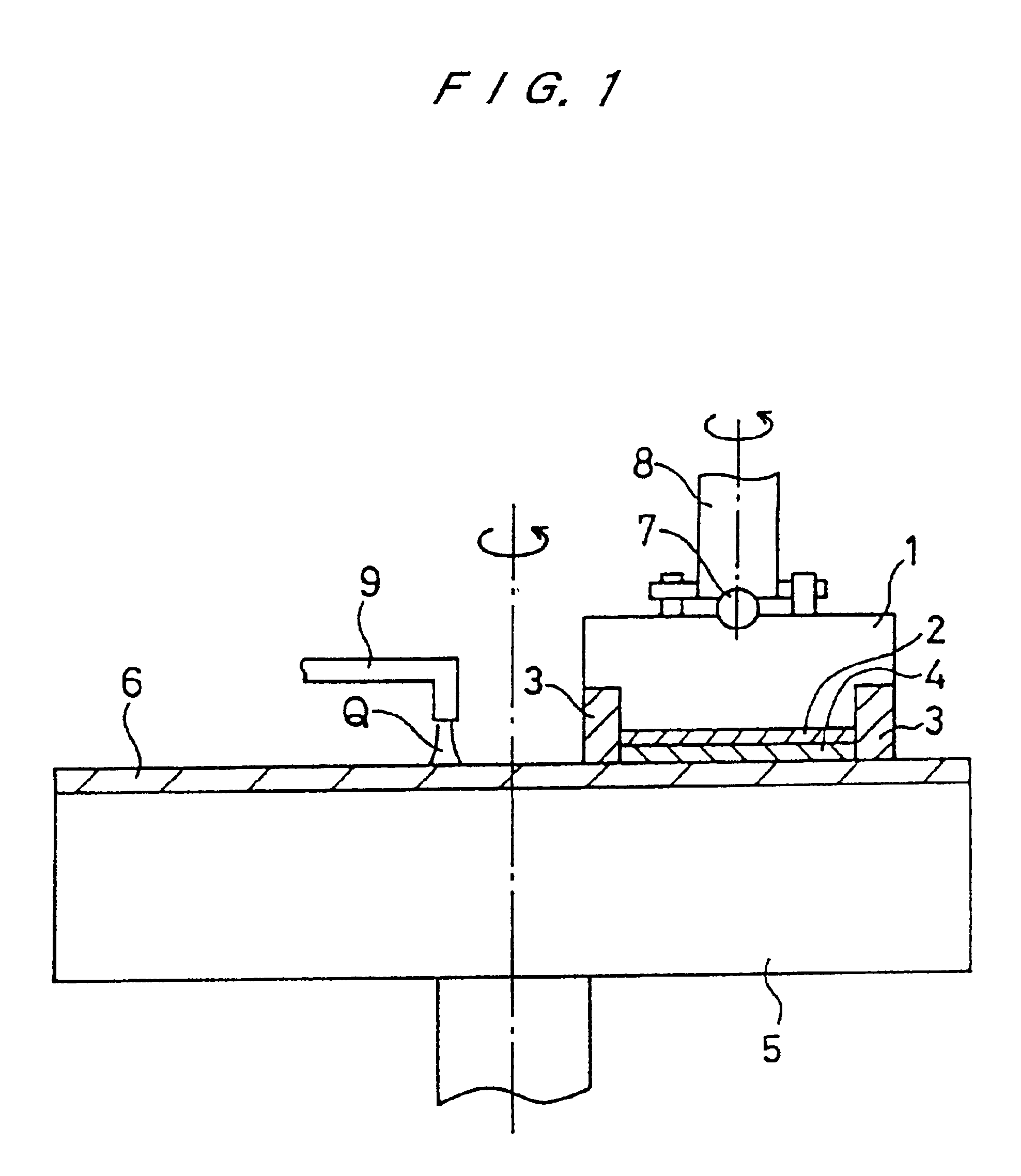Polishing method using an abrading plate
a technology of abrading plate and polishing plate, which is applied in the direction of manufacturing tools, abrasive surface conditioning devices, lapping machines, etc., can solve the problems of reducing the polishing rate, the inability to operate the self-stopping function, and the continual grinding of the surface, so as to achieve stable polishing rate, reduce the amount of surface removal, and reduce the effect of polishing ra
- Summary
- Abstract
- Description
- Claims
- Application Information
AI Technical Summary
Benefits of technology
Problems solved by technology
Method used
Image
Examples
first embodiment
[0103]FIGS. 18A, 18B are schematic illustrations of the process of the present method. The first stage polishing is shown in FIG. 18A, and is based on the polishing using the abrading plate described above. This abrading plate has a self-stopping property that enables the reduction of the rate of material removal when the raised regions of the semiconductor device patterned wafer are preferentially eliminated and the irregularities are eliminated by polishing while supplying only water W from the nozzle 10. However, when it is necessary to control the film thickness to a certain value, this abrading plate is not suitable because further polishing does not remove the surface material, due to working of the self-stopping function.
[0104]For this reason, first, polishing time is controlled so as to recognize that the irregularities have been eliminated. Then, in the second stage polishing shown in FIG. 18B, additional polishing is carried out by replacing water with a polishing slurry c...
second embodiment
[0108]FIGS. 23A, 23B show the polishing method. FIG. 23A shows a second stage polishing apparatus used for the first stage polishing using the abrading plate, and FIG. 23B shows a polishing apparatus having a diamond dresser 16 added to the apparatus shown in FIG. 23A. Diamond dresser 16 comprises fine diamond particles of about #200 particle size embedded in the abrading surface of the abrading plate 15, and performs conditioning of the abrading plate 15 using water W. As illustrated, on one location on the surface of a rotating turntable 5, polishing of wafer W is carried out by the abrading plate, while, on the other location, dressing of the abrading plate is carried out by pressing the dresser 16 on the abrading surface of the abrading plate while supplying water W from the nozzle 10.
[0109]The first and second stage polishing in the second embodiment are controlled by switching a series of valves using the switching apparatus shown in FIG. 24 according to the flowchart shown in...
third embodiment
[0110]FIGS. 26A, 26B show the polishing method schematically, and FIG. 27 shows a plan view of the apparatus. A wafer 4 that has passed through the first stage polishing using the abrading plate 15 shown in FIG. 26A is transferred to a conventional CMP apparatus shown in FIG. 26B using a polishing cloth 6 and slurry containing abrasive particles through a conventional chemical and mechanical polishing process. This CMP operation can be carried out using a single conventional apparatus, but it may be used in a combined manner with the polishing apparatus comprising the abrading plate so that both may be used in a complementary manner. Namely, because of the self-stopping function of the abrading plate using water or chemical solution, surface material removal will not proceed after the irregularities are eliminated in the process of polishing even in a subsequent polishing process. On the other hand, since the polishing cloth of conventional chemical mechanical polishing has elastici...
PUM
| Property | Measurement | Unit |
|---|---|---|
| height | aaaaa | aaaaa |
| height | aaaaa | aaaaa |
| height | aaaaa | aaaaa |
Abstract
Description
Claims
Application Information
 Login to View More
Login to View More - R&D
- Intellectual Property
- Life Sciences
- Materials
- Tech Scout
- Unparalleled Data Quality
- Higher Quality Content
- 60% Fewer Hallucinations
Browse by: Latest US Patents, China's latest patents, Technical Efficacy Thesaurus, Application Domain, Technology Topic, Popular Technical Reports.
© 2025 PatSnap. All rights reserved.Legal|Privacy policy|Modern Slavery Act Transparency Statement|Sitemap|About US| Contact US: help@patsnap.com



